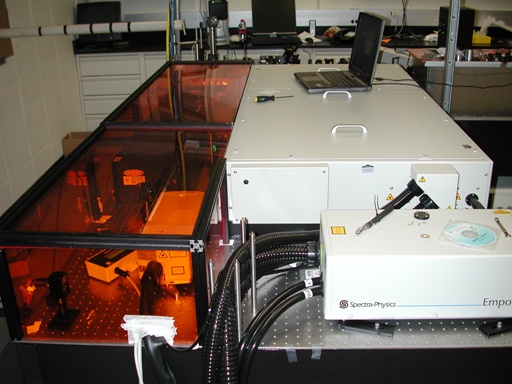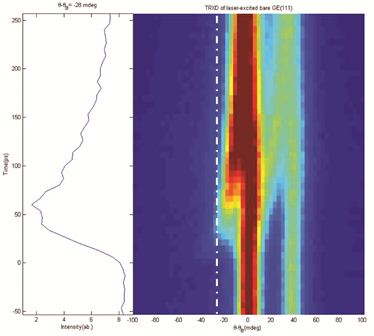Research
The DeCamp lab uses ultrafast radiation to study the sub-picosecond dynamics of complex systems. This ranges from the structural dynamics of crystalline systems to molecular dynamics in solution. The DeCamp Lab is developing several time-domain spectroscopic tools to fulfill these goals, including time-resolved x-ray scattering, time-domain THz spectroscopy, and time-domain optical spectroscopy.
Laser system
The backbone of any ultrafast spectroscopy lab is the laser source. The DeCamp lab has a 1kHz Spectra-Physics Spitfire XP amplifier seeded by a KMLabs Oscillator. The laser generates 3mJ, sub-40fs laser pulses for ultrafast spectroscopy. The laser output has been upgraded to produce 5+mJ at 1kHz by the construction of a home built, LN2 cooled multipass power amplifier. Using modest focusing, this laser is able to generate optical fields greater than 10^{17}W/cm^2.
Time-resolved X-ray diffraction
We are currently utilizing a sub-picosecond x-ray source based upon generation of a dense plasma via intense (>10^15 W/cm2) laser excitation of solid targets, specifically a copper wire. In conjunction with stroboscopic pump-probe techniques, we are able to measure structural changes in crystals as small as 10^{-13}m with picosecond time resolution. The figure below demonstrates the capabilities of the system by measuring the sub-picosecond optical excitation of a Germanium (111) crystal. The generation of x-ray diffraction sidebands indicate the presence of a transient acoustic wave inside the bulk crystal.
Current experiments utilizing this x-ray source for the study of the ultrafast lattice dynamics of nanostructured systems.
Time-Domain Terahertz spectroscopy
THz radiation is the wavelength range of .020-1mm and can have pulse lengths as fast as 30fs. While these wavelengths are relatively long, it is the spectral region of low frequency molecular vibrations and rotations, making this a useful range for molecular spectroscopy. Producing pulsed THz radiation can easily accomplished by rapidaly accelerating charged particles. This is typcially accomplished via ultrafast excitation of semiconductors or the rapid generation of a dense electron plasma. We have produced and measured coherent THz radiation from a dense laser-driven plasma in a copper target. This radiation is a direct measurement of the electron dynamics within the plasma, providing a novel method to performing laser-plasma diagnostics.


